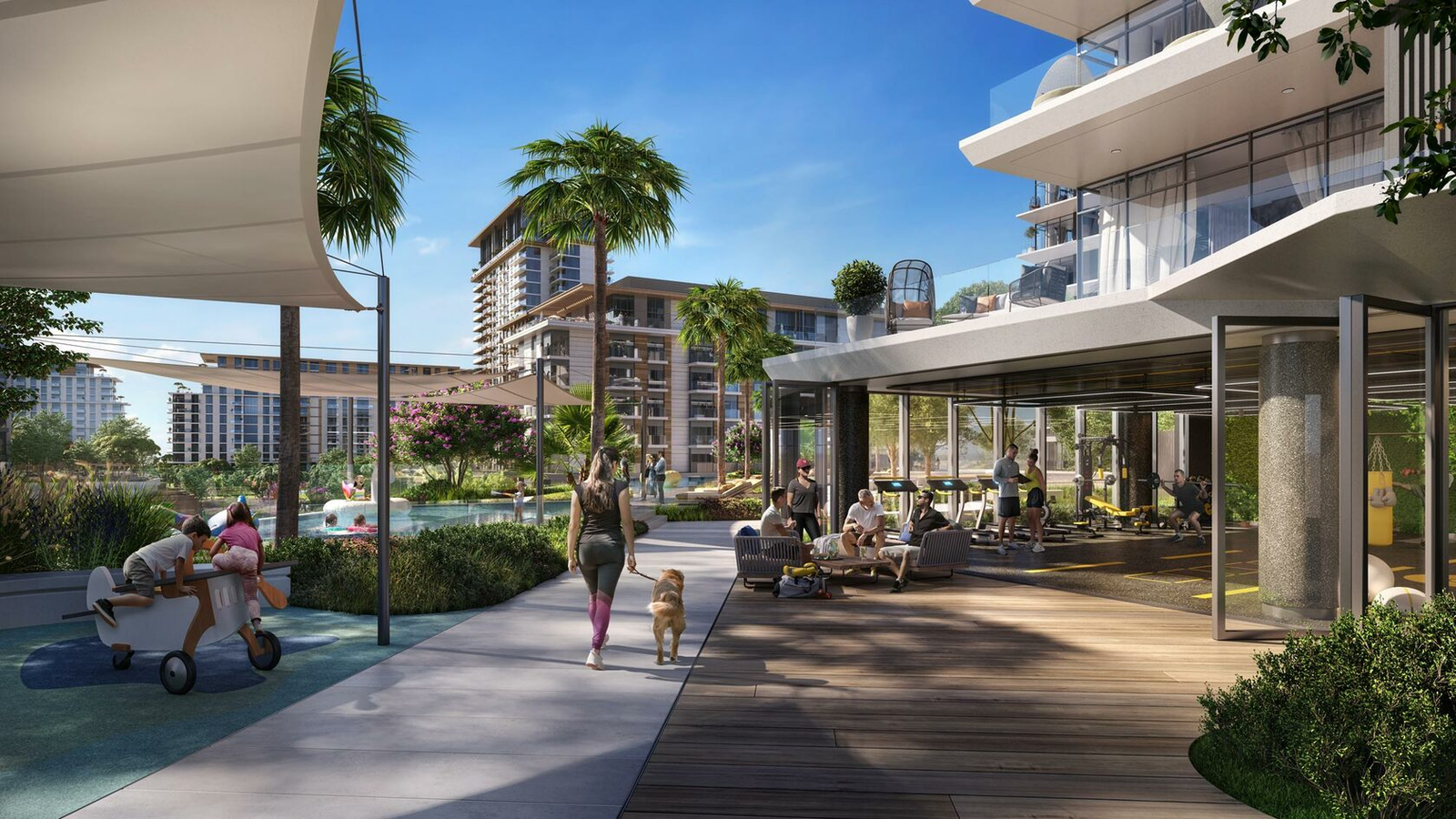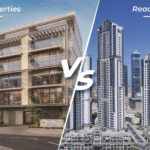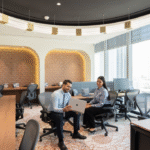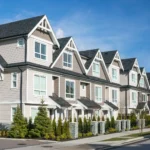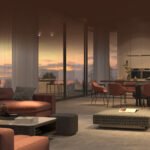Now Reading: Dubai Villas 2025: Real Estate Projects Offering Sustainable Lifestyle
-
01
Dubai Villas 2025: Real Estate Projects Offering Sustainable Lifestyle
Dubai Villas 2025: Real Estate Projects Offering Sustainable Lifestyle
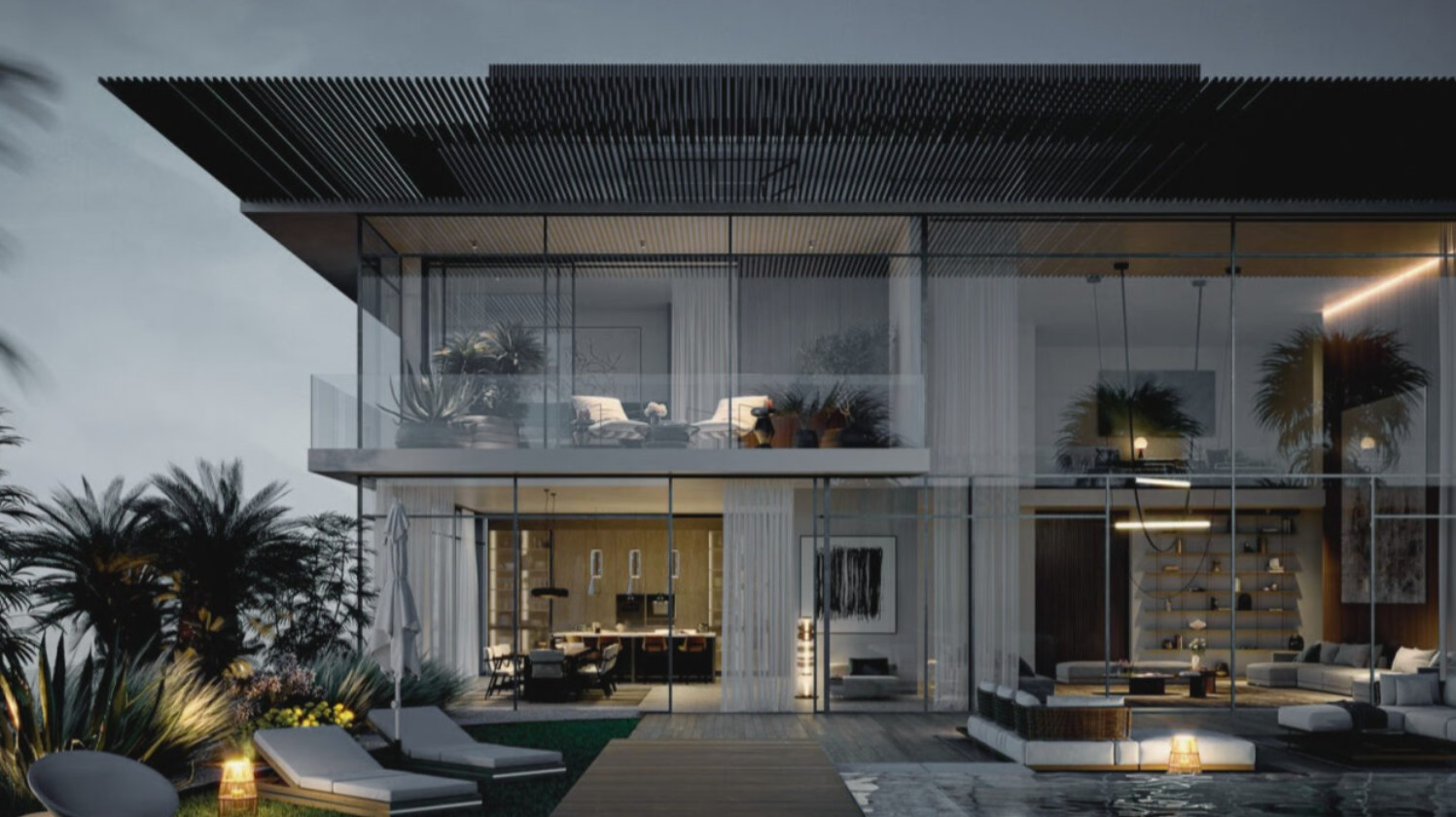
Table of Contents
Imagine stepping out onto the terrace of your sprawling villa, solar panels quietly powering your home, a lush private garden blooming below, and a vibrant community hosting eco-friendly events like farmers’ markets just steps away. This is the promise of Dubai’s villas in 2025, where real estate projects are blending sustainable living with luxurious comfort, captivating families, professionals, and investors worldwide. These aren’t just homes they’re eco-conscious sanctuaries that nurture both the planet and the people who live in them, set in a city that feels both visionary and warm.
Dubai is a global hub that thrives on innovation, weaving cutting-edge technology with a multicultural spirit. In 2025, villa communities like Dubai Hills Estate, Mohammed Bin Rashid City (MBR City), Jumeirah Village Circle (JVC), and Dubai Sustainable City are leading the real estate surge, offering homes designed for sustainable lifestyles. With solar-powered villas, smart systems, and green spaces, these projects are redefining what it means to live well in Dubai. Let’s explore why these sustainable villas are driving global interest.
The Allure of Sustainable Villas
What makes Dubai’s sustainable villas so irresistible? It’s their seamless integration of eco-friendly design with luxurious living. Picture yourself in a Dubai Hills Estate villa, your rooftop solar panels reducing your carbon footprint while you sip coffee overlooking a golf course. Or imagine an MBR City mansion with smart irrigation nurturing your private garden, or a JVC villa surrounded by 33 parks perfect for family bike rides. Dubai Sustainable City offers car-free zones and urban farms, creating a green oasis. These communities, crafted by developers like Emaar, Nakheel, and SEE Holding, are built to harmonize with the environment while fostering connection.
Each community has a unique eco-vibe. Dubai Hills Estate blends upscale living with sustainable landscaping, featuring the Dubai Hills Mall and an 18-hole golf course. MBR City dazzles with its 7-km Crystal Lagoons powered by renewable energy, ideal for eco-conscious luxury seekers. JVC’s village-like charm includes parks and shaded walkways, while Dubai Sustainable City is a pioneer with solar-powered villas and organic farms. Residents enjoy amenities like rooftop gardens, EV charging stations, and smart home systems, alongside proximity to top schools like GEMS International and business hubs like DIFC, just 15-30 minutes away.
The villas are designed for sustainable living. Dubai Hills’ Golf Place offers 4- to 6-bedroom villas with solar panels and private green spaces. MBR City’s District One features mansions with energy-efficient designs and lagoon views. JVC’s Circle Villas provide 3- to 5-bedroom layouts with sustainable materials, and Dubai Sustainable City’s villas include rooftop solar arrays and smart water systems. These homes combine green technology like AI-driven energy monitoring and low-carbon construction with lifestyle amenities like private pools and community fitness hubs, creating spaces that feel both luxurious and earth-friendly.
Why Sustainable Villas Are in Demand
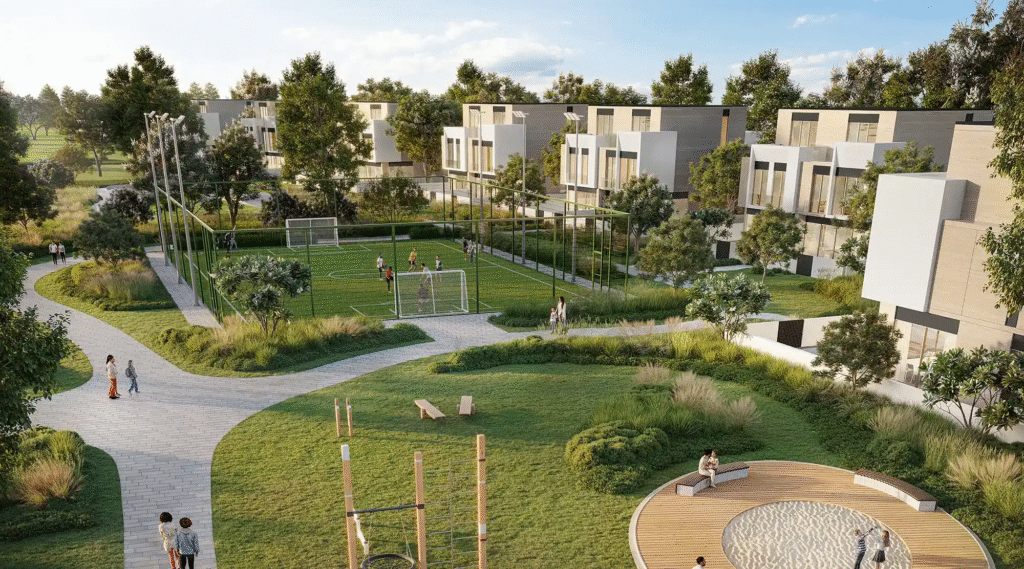
The numbers behind Dubai’s sustainable villas are compelling. In 2025, property values are rising 9-13% year-on-year, aligning with Dubai’s 11.3% market average. MBR City villas average AED 10-25 million, with 15% growth over five years, while JVC villas range from AED 2-4 million, up 12% annually. Dubai Hills villas fetch AED 10-20 million, and Dubai Sustainable City villas average AED 2.5-5 million, with 12% growth. Rental yields are strong at 5-7%, driven by demand from eco-conscious families, professionals, and expatriates. Short-term rentals, fueled by Dubai’s 17.2 million visitors in 2024 and a projected 25 million by 2030, achieve 70-80% occupancy, with nightly rates of AED 1,000-5,000.
Sustainability and lifestyle drive this demand. Residents are drawn to features like solar power, smart irrigation, and community recycling programs, reflecting a global shift toward eco-conscious living. JVC and Dubai Sustainable City offer affordability, making them ideal for young families, while Dubai Hills and MBR City attract affluent buyers seeking green luxury. Off-plan projects, like Sobha Hartland II in MBR City and Park Heights 3 in Dubai Hills, account for 40-50% of sales, with buyers snapping up units for their eco-features and growth potential. Dubai’s reputation as a safe, vibrant hub attracts buyers from Europe, Asia, and North America.
Dubai’s investor-friendly policies fuel the trend. Full freehold ownership allows global buyers to invest without restrictions, and the UAE’s tax-free environment no income, property, or capital gains taxes maximizes returns. Off-plan properties require just 10-20% upfront, lowering the entry barrier. High-value purchases qualify for the UAE’s Golden Visa, offering residency benefits that appeal to families and professionals. Connectivity is seamless, with Sheikh Zayed Road, Al Khail Road, and the Dubai Metro linking these communities to Downtown Dubai and DIFC within 15-30 minutes.
A Lifestyle That Feels Balanced
Living in Dubai’s sustainable villa communities is about more than green technology it’s about connection and joy. In Dubai Sustainable City, residents shop at urban farms and join community composting workshops. Dubai Hills offers golf course strolls, eco-friendly festivals at the Dubai Hills Mall, and family yoga sessions in green spaces. MBR City’s Crystal Lagoons host sustainable water sports and waterfront picnics, while JVC’s 33 parks are perfect for family bike rides and community barbecues. These neighborhoods are designed to foster eco-living, with car-free zones, recycling programs, and community centers that bring people together.
Take Aisha, a mother of three in JVC. “The parks are our playground,” she says. “We cycle as a family, and it feels so green.” Omar, a professional in Dubai Hills, loves the sustainability. “My villa’s solar panels save energy, and the community is vibrant,” he shares. Noor, a young mother in Dubai Sustainable City, cherishes the eco-vibe. “Our home runs on solar power, and we grow our own veggies,” she says. In MBR City, Sarah, a British expat, adores the lagoon. “We have picnics by the water, and it’s so eco-friendly,” she says.
Sustainability is the heart of these communities. Projects like Dubai Sustainable City and Dubai Hills incorporate solar panels, smart irrigation, and low-carbon materials, aligning with the Dubai 2040 Urban Master Plan. JVC’s green spaces and MBR City’s renewable energy initiatives reduce car reliance, while Sobha Hartland II features EV charging stations and AI-driven utilities, appealing to eco-conscious buyers. These efforts make Dubai’s villas not just sustainable but visionary.
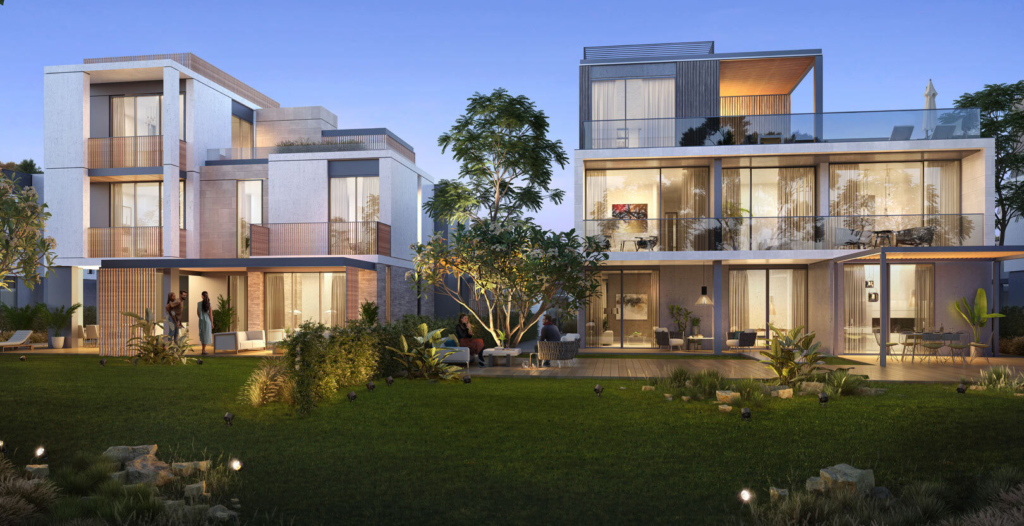
Challenges to Navigate
These communities come with hurdles. Maintenance fees average AED 8-12 per square foot in JVC and AED 10-15 in Dubai Hills, MBR City, and Dubai Sustainable City, higher than in emerging areas like Dubai South. Ongoing construction in newer phases, like Sobha Hartland II or Park Heights 3, may bring temporary noise or delays. The short-term rental market, while lucrative, faces competition from hotels, which could pressure yields in oversaturated periods.
Yet, these challenges are part of the opportunity. Maintenance fees support eco-friendly amenities, from solar-powered pools to 24-hour security, which attract residents and tenants. Early investment in developing phases offers lower prices, with historical trends showing 15-20% appreciation for early buyers in JVC and Dubai Sustainable City. Dubai’s real estate market, with $142.4 billion in sales in 2024, remains robust, and sustainable villas are a leading driver.
Stories That Bring It to Life
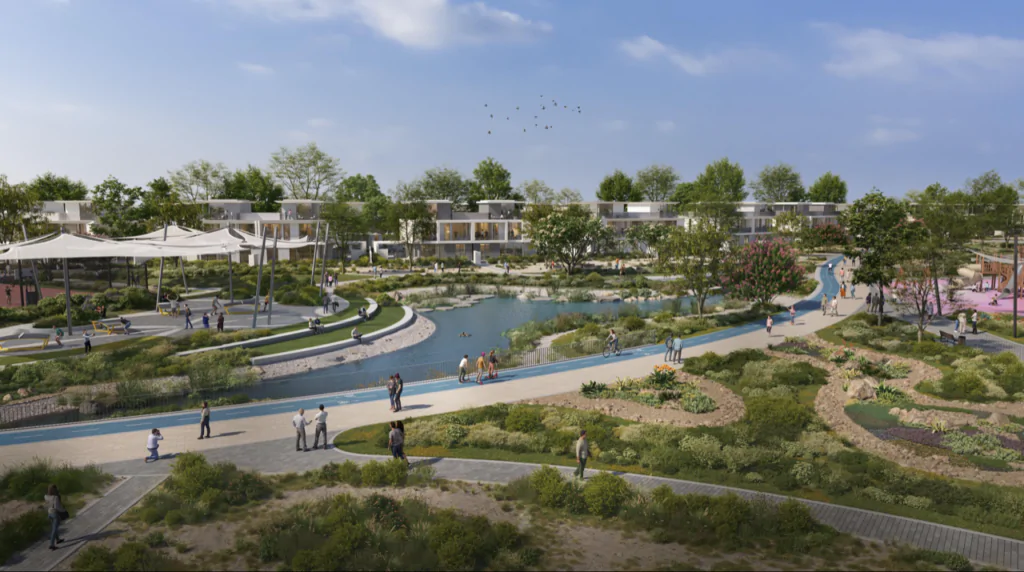
The human stories behind Dubai’s sustainable villas make them shine. Khalid, a father in JVC, loves the eco-vibe. “We cycle in the park, and the kids join green workshops,” he says. Maya, a professional in Dubai Hills, cherishes the sustainability. “My villa’s solar panels are a game-changer,” she says. Sarah, a retiree in MBR City, enjoys the tranquility. “The lagoon views and eco-designs are a dream,” she says. In Dubai Sustainable City, Ahmed sees both profit and joy. “My villa was AED 3 million, and it’s up 10%,” he shares. “But I love the urban farm.”
These stories reflect the dual appeal of Dubai’s villas: they’re eco-friendly sanctuaries and smart investments. Whether it’s a bike ride in JVC, a green festival in Dubai Hills, or a farm-to-table meal in Dubai Sustainable City, these communities create moments that linger.
Tips for Aspiring Buyers
Ready to dive into Dubai’s sustainable villa market? Here’s how to make it happen:
- Research Market Trends: Study price growth and rental yields in JVC, Dubai Hills, MBR City, and Dubai Sustainable City to find high-potential opportunities.
- Choose Trusted Developers: Work with Emaar, Nakheel, or SEE Holding for quality and reliability.
- Plan for the Long Term: Aim for a 5-10 year horizon to maximize appreciation, especially in off-plan projects.
- Leverage Expertise: A local real estate agent or lawyer can navigate freehold laws and secure the best deals.
The Future of Sustainable Living
In 2025, Dubai’s sustainable villas are more than real estate they’re a vision of eco-conscious living. New projects like Sobha Hartland II, Park Heights 3, and expansions in Dubai Sustainable City are pushing the boundaries of green luxury. As Dubai aims for 25 million visitors by 2030, these communities will remain vibrant hubs, driving property values and rental demand higher.
For residents, it’s about the joy of sustainable living park bike rides, lagoon picnics, and green community events. For investors, it’s a chance to build wealth in a city that’s rewriting the rules of real estate. Dubai’s sustainable villas are where dreams meet reality, offering a luxurious, eco-friendly lifestyle that’s hard to resist. In 2025, these projects aren’t just trending they’re shaping the future of Dubai’s green charm.
read more: Wellness Apartments in Dubai 2025: Designed for Healthy Living




